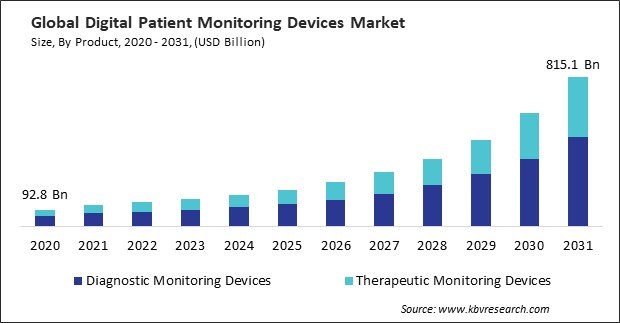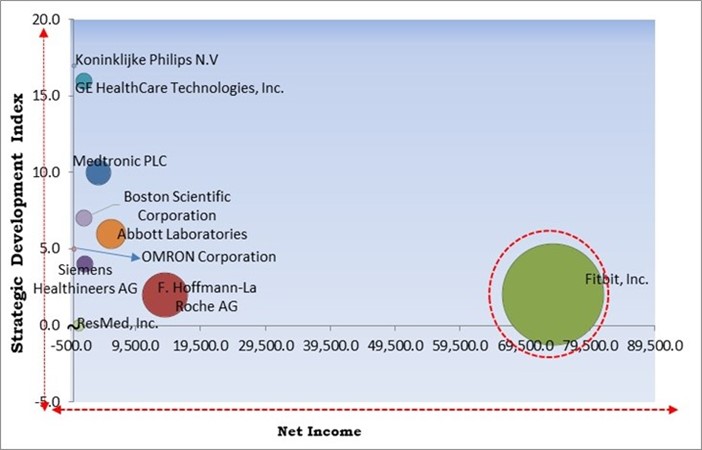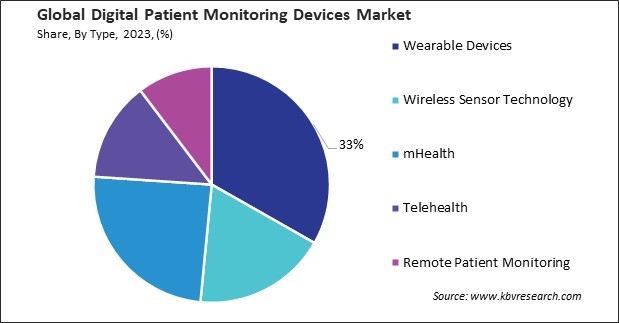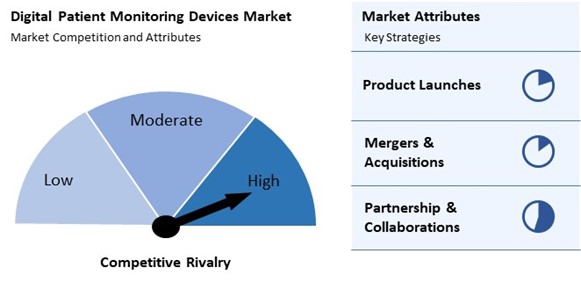“Global Digital Patient Monitoring Devices Market to reach a market value of 815.1 Billion by 2031 growing at a CAGR of 24.9%”
The Global Digital Patient Monitoring Devices Market size is expected to reach $815.1 Billion by 2031, rising at a market growth of 9.0% CAGR during the forecast period.
The rise of smartphones, increasing internet accessibility, and a growing awareness of proactive health management have all contributed to the segment's growth. mHealth has proven particularly impactful in underserved regions, providing an affordable way to access healthcare information and services. Hence, the mHealth segment witnessed 1/4th revenue share in the market in 2023. The segment's growth is driven by the proliferation of mobile health applications supporting patient engagement, medication adherence, and smartphone health tracking. mHealth apps provide valuable health data insights, facilitate remote consultations, and allow users to manage chronic conditions through personalized alerts and reminders.

The major strategies followed by the market participants are Partnerships as the key developmental strategy to keep pace with the changing demands of end users. For instance, In September, 2024, Roche partnered with Respiree, a Singapore-based health technology company, to enhance patient monitoring in the Asia Pacific region. The collaboration combines Roche’s cobas pulse blood glucose monitoring system with Respiree’s vital sign monitoring solution, offering real-time data and bedside insights. Additionally, in April, 2024, GE HealthCare Technologies formed a collaboration with AMC Health, a leader in telehealth and remote patient monitoring, to provide enhanced remote monitoring services. The collaboration focuses on integrating AMC Health’s remote patient monitoring technology with GE’s healthcare solutions to improve patient outcomes and healthcare provider efficiency.
Based on the Analysis presented in the KBV Cardinal matrix; Fitbit, Inc. is the forerunner in the Market. In January, 2024, Fitbit and Quest Diagnostics, a leading provider of diagnostic testing services, collaborated on the Wearables for Metabolic Health (WEAR-ME) study. This pilot project combines Fitbit's behavioral and biometric data with Quest's lab tests to improve insights into metabolic health and disease prevention. Companies such as F. Hoffmann-La Roche AG, Abbott Laboratories, Medtronic PLC are some of the key innovators in Digital Patient Monitoring Devices Market.

personalized medicine emphasizes preventive care by early identification of potential health risks, thereby reducing the likelihood of severe complications and costly interventions made possible by digital monitoring. This method is consistent with the growing emphasis on sustainable and efficient healthcare, as personalized treatment plans alleviate the overall burden on healthcare systems by preventing emergency visits and hospitalizations. As digital monitoring devices become more advanced, personalized medicine will continue to pave the way for a more efficient, adaptive, patient-centered healthcare system that benefits individuals and healthcare providers. Therefore, all these factors are driving the expansion of the market.
Wearable technology has made digital patient monitoring devices more accessible and user-friendly, encouraging broader adoption. Smartwatches, fitness trackers, and specialized health monitoring wearables have grown in popularity, giving users a convenient way to track their health metrics daily. Wearables now offer a variety of features, from tracking vital signs and sleep quality to alerting users to abnormal readings. This ease of use has expanded its appeal to patients with specific health needs and health-conscious consumers. IoT, AI, and wearable tech have also streamlined healthcare workflows, improving communication between patients and healthcare providers. Thus, these developments will aid in the growth of the market.
The high costs can be prohibitive for patients, especially those with chronic conditions who would benefit from personal monitoring devices at home. This disparity in access creates a digital divide, where only patients from wealthier backgrounds or regions with better healthcare funding can afford these advanced tools. Consequently, the high cost of advanced digital monitoring devices hinders their adoption on a global scale, thereby impeding the market's growth.

The leading players in the market are competing with diverse innovative offerings to remain competitive in the market. The above illustration shows the percentage of revenue shared by some of the leading companies in the market. The leading players of the market are adopting various strategies in order to cater demand coming from the different industries. The key developmental strategies in the market are Partnerships, Collaborations and Agreements.
On the basis of type, the market is divided into wearable devices, wireless sensor technology, mHealth, telehealth, and remote patient monitoring. The wearable devices segment recorded 33% revenue share in the market in 2023. Devices like fitness trackers, smartwatches, and wearable ECG monitors allow patients and individuals to monitor vital health metrics in real-time. The popularity of wearables for personal as well as professional health management is a result of their user-friendly designs, advancements in data analytics, and convenience and accessibility. This segment's growth highlights the demand for non-invasive, portable, and easily accessible digital health solutions.
Based on product, the market is bifurcated into diagnostic monitoring devices and therapeutic monitoring devices. The therapeutic monitoring devices segment procured 38% revenue share in the market in 2023. Devices in this category, such as blood glucose monitors, respiratory function monitors, and devices for managing post-operative recovery, are essential for continuous, real-time tracking of treatment effectiveness and patient response. The demand for these devices has been further bolstered by the increasing trend of personalized healthcare, which offers valuable insights for customizing treatments to meet the unique requirements of each individual.

On the basis of remote patient monitoring type, the market is classified into hospital inpatient, ambulatory patient, and smart home healthcare. The hospital inpatient segment acquired 51% revenue share in the market in 2023. The segment's expansion is fueled by the growing prevalence of sophisticated monitoring systems in hospital environments. These systems facilitate the early detection of prospective health issues and the timely implementation of interventions by facilitating continuous monitoring of vital signs.
Free Valuable Insights: Global Digital Patient Monitoring Devices Market size to reach USD 815.1 Billion by 2031
Region-wise, the market is analyzed across North America, Europe, Asia Pacific, and LAMEA. The North America segment procured 40% revenue share in the market in 2023. The regional market's expansion is fueled by the region's sophisticated healthcare infrastructure, a high adoption rate of innovative medical technologies, and a growing emphasis on preventive healthcare. Further, the demand for continuous health monitoring solutions has been exacerbated by the prevalence of chronic diseases, including cardiovascular disorders and diabetes.

The Digital Patient Monitoring Devices Market is highly competitive, driven by the increasing demand for remote healthcare solutions and enhanced patient care. Providers are focused on developing innovative monitoring devices that offer real-time data on vital signs, enabling healthcare professionals to make informed decisions promptly. As the shift towards telehealth and home healthcare continues, competition intensifies around features such as connectivity, accuracy, and user-friendliness. Additionally, integration with electronic health records and wearable technology is essential for maintaining a competitive edge in this rapidly evolving market.
| Report Attribute | Details |
|---|---|
| Market size value in 2023 | USD 149.9 Billion |
| Market size forecast in 2031 | USD 815.1 Billion |
| Base Year | 2023 |
| Historical Period | 2020 to 2022 |
| Forecast Period | 2024 to 2031 |
| Revenue Growth Rate | CAGR of 24.9% from 2024 to 2031 |
| Number of Pages | 385 |
| Tables | 553 |
| Report coverage | Market Trends, Revenue Estimation and Forecast, Segmentation Analysis, Regional and Country Breakdown, Competitive Landscape, Market Share Analysis, Porter’s 5 Forces Analysis, Company Profiling, Companies Strategic Developments, SWOT Analysis, Winning Imperatives |
| Segments covered | Product, Type, Region |
| Country scope |
|
| Companies Included | Siemens Healthineers AG (Siemens AG), GE HealthCare Technologies, Inc., Medtronic PLC, F. Hoffmann-La Roche AG, Koninklijke Philips N.V, Abbott Laboratories, Boston Scientific Corporation, OMRON Corporation, Fitbit, Inc. (Google LLC), ResMed, Inc. |
By Product
By Type
By Geography
This Market size is expected to reach $815.1 Billion by 2031.
Rising Prevalence of Chronic Diseases are driving the Market in coming years, however, High Costs of Advanced Monitoring Devices restraints the growth of the Market.
Siemens Healthineers AG (Siemens AG), GE HealthCare Technologies, Inc., Medtronic PLC, F. Hoffmann-La Roche AG, Koninklijke Philips N.V, Abbott Laboratories, Boston Scientific Corporation, OMRON Corporation, Fitbit, Inc. (Google LLC), ResMed, Inc.
The expected CAGR of this Market is 24.9% from 2024 to 2031.
The Diagnostic Monitoring Devices segment is leading the Market by Product in 2023; thereby, achieving a market value of $487.9 billion by 2031.
The North America region dominated the Market by Region in 2023; thereby, achieving a market value of $307.8 billion by 2031.
Our team of dedicated experts can provide you with attractive expansion opportunities for your business.

 Drivers
Drivers
 Restraints
Restraints
 Opportunities
Opportunities
 Challenges
Challenges
